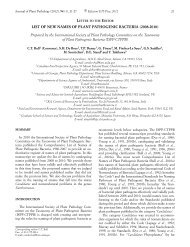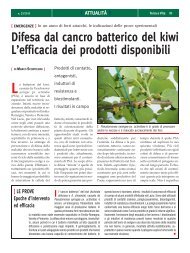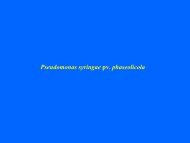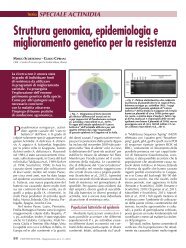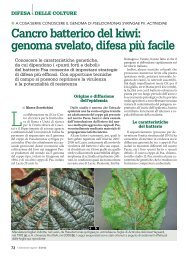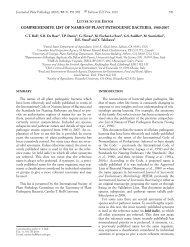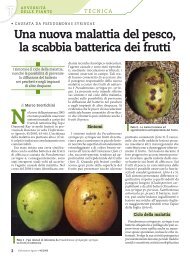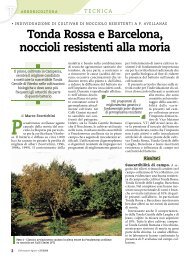Identification of Pseudomonas syringae pv. actinidiae as Causal ...
Identification of Pseudomonas syringae pv. actinidiae as Causal ...
Identification of Pseudomonas syringae pv. actinidiae as Causal ...
You also want an ePaper? Increase the reach of your titles
YUMPU automatically turns print PDFs into web optimized ePapers that Google loves.
J Phytopathol 157:768–770 (2009) doi: 10.1111/j.1439-0434.2009.01550.x<br />
Ó 2009 Blackwell Verlag GmbH<br />
Short Communication<br />
C.R.A. – Centro di Ricerca per la Frutticoltura, Roma, Italy<br />
<strong>Identification</strong> <strong>of</strong> <strong>Pseudomon<strong>as</strong></strong> <strong>syringae</strong> <strong>pv</strong>. <strong>actinidiae</strong> <strong>as</strong> <strong>Causal</strong> Agent <strong>of</strong> Bacterial<br />
Canker <strong>of</strong> Yellow Kiwifruit (Actinidia chinensis Planchon) in Central Italy<br />
Patrizia atrizia Ferrante errante and Marco arco Scortichini cortichini<br />
AuthorsÕ address: C.R.A. – Centro di Ricerca per la Frutticoltura, Via di Fioranello, 52; 00134 Roma, Italy<br />
(correspondence to Marco Scortichini. E-mail: marco.scortichini@entecra.it)<br />
Received August 26, 2008; accepted December 16, 2008<br />
Keywords: kiwifruit, yellow kiwifruit, <strong>Pseudomon<strong>as</strong></strong> <strong>syringae</strong>, ERIC-PCR<br />
Abstract<br />
Angular, necrotic leaf spot, longitudinal cracks along<br />
the petiole, oozing and wilting <strong>of</strong> branches were<br />
observed during summer 2008 on Actinidia chinensis<br />
(yellow kiwifruit) cultivar Hort16A, cultivated in different<br />
orchards located the province <strong>of</strong> Latina (central<br />
Italy). Symptoms closely resembled those incited by<br />
<strong>Pseudomon<strong>as</strong></strong> <strong>syringae</strong> <strong>pv</strong>. <strong>actinidiae</strong> on kiwifruit<br />
A. deliciosa. Isolates obtained from typical lesions were<br />
<strong>as</strong>sessed by means <strong>of</strong> biochemical, pathogenicity and<br />
host range tests and compared with some <strong>Pseudomon<strong>as</strong></strong><br />
<strong>syringae</strong> pathovars by enterobacterial repetitive intergenic<br />
consensus (ERIC-PCR) analysis. The isolates<br />
belong to <strong>Pseudomon<strong>as</strong></strong> LOPAT group Ia, incited the<br />
death <strong>of</strong> pot-cultivated A. chinensis cv. Hort 16A and<br />
A. deliciosa cv. Hayward plants in few days, but did<br />
not cause any symptoms to the other inoculated plant<br />
species. Upon ERIC-PCR analysis, all the isolates<br />
showed similarity with P. <strong>syringae</strong> <strong>pv</strong>. <strong>actinidiae</strong><br />
NCPPB 3739, type-strain <strong>of</strong> the pathovar. This is the<br />
first report <strong>of</strong> this pathogen on A. chinensis in Italy<br />
and, <strong>as</strong> far <strong>as</strong> we currently know, in the world.<br />
Introduction<br />
In Italy, kiwifruit (Actinidia deliciosa Liang et Ferguson)<br />
is cultivated on approximately 22 000 hectares<br />
and the main are<strong>as</strong> <strong>of</strong> cultivation are located in<br />
Latium, Piedmont, Emilia-Romagna, Veneto and<br />
Campania. In recent years, the golden or yellow kiwifruit<br />
(Actinidia chinensis Planchon) h<strong>as</strong> also been introduced<br />
into limited are<strong>as</strong> <strong>of</strong> Italy, especially in Latium<br />
and Emilia-Romagna regions. <strong>Pseudomon<strong>as</strong></strong> <strong>syringae</strong><br />
<strong>pv</strong>. <strong>actinidiae</strong>, the causal agent <strong>of</strong> bacterial canker <strong>of</strong><br />
kiwifruit, w<strong>as</strong> reported on A. deliciosa in the Latium<br />
region for the first time in 1994 (Scortichini, 1994).<br />
After this record, the bacterium w<strong>as</strong> isolated again in<br />
other few occ<strong>as</strong>ions in the same area (Scortichini,<br />
unpublished data). This phytopathogen causes important<br />
economic losses on kiwifruit also in Japan (Takikawa<br />
et al., 1989), South Korea (Koh et al., 1994) and<br />
Iran (Mazarei and Most<strong>of</strong>ipour, 1994).<br />
During spring 2008, symptoms resembling those<br />
incited by P. s. <strong>pv</strong>. <strong>actinidiae</strong> (i.e. angular leaf spots,<br />
elongated cracks along the petiole, whitish oozing<br />
from the trunk, wilting <strong>of</strong> branches) were observed in<br />
some A. chinensis cultivar Hort 16A orchards cultivated<br />
in Latium. The dise<strong>as</strong>e caused death <strong>of</strong><br />
branches, on up to 3–5% <strong>of</strong> the plants present in the<br />
orchard. These observations prompted us in performing<br />
isolation and identification <strong>of</strong> the pathogenic<br />
bacterium isolated from the plant lesions.<br />
This study reports on for the first time, the identification<br />
<strong>of</strong> P. s. <strong>pv</strong>. <strong>actinidiae</strong> <strong>as</strong> the causal agent <strong>of</strong><br />
bacterial canker <strong>of</strong> yellow kiwifruit in Italy, and <strong>as</strong> far<br />
<strong>as</strong> we currently know, in the world.<br />
Materials and Methods<br />
Isolation<br />
Fragments <strong>of</strong> infected tissues were <strong>as</strong>eptically removed<br />
from lesion margins <strong>of</strong> leaves, petiole and trunk and<br />
ground into sterile mortars containing 5 ml <strong>of</strong> sterile<br />
saline solution, (SS) (NaCl 0.85% in sterile distilled<br />
water). Subsequently, 0.1 ml aliquots <strong>of</strong> serial 10-fold<br />
dilutions were plated on nutrient agar containing 5%<br />
<strong>of</strong> sucrose (NSA) and incubated at 25–27°C for<br />
3 days.<br />
Biochemical and pathogenicity tests<br />
With colonies grown on NSA plates, pure cultures<br />
were obtained and with representative isolates, the following<br />
biochemical tests were performed according to<br />
the procedures described by Lelliott and Stead (1987):<br />
levan production, presence <strong>of</strong> oxid<strong>as</strong>e, s<strong>of</strong>t rot activity<br />
on potato slices, presence <strong>of</strong> arginine dehydrol<strong>as</strong>e,<br />
hypersensitivity reaction in tobacco leaves (LOPAT
Bacterial Canker <strong>of</strong> Yellow Kiwifruit<br />
tests), metabolism <strong>of</strong> glucose, hydrolysis <strong>of</strong> aesculin,<br />
gelatine hydrolysis and fluorescence on the medium B<br />
<strong>of</strong> King et al. (1954) (KB). In addition, the utilization<br />
<strong>of</strong> sorbitol, inositol, erythritol, adonitol, glycerol, mannitol,<br />
l-alanine, l-tyrosine, arabinose, d-xylose and<br />
d-fructose w<strong>as</strong> <strong>as</strong>sessed.<br />
Pathogenicity and host range tests were performed<br />
using the 10 isolates obtained from yellow kiwi fruit<br />
Hort16A and belonging to LOPAT tests group Ia and<br />
P. s. <strong>pv</strong>. <strong>actinidiae</strong> NCPPB 3739, pathotype strain, isolated<br />
from A. deliciosa in Japan. For inoculation, colonies<br />
grown on NSA for 24 h, at 25–27°C were used.<br />
Bacterial suspensions corresponding to 1–2 · 10 6<br />
cfu ml )1 were prepared in SS. Pot-cultivated A. chinensis<br />
Hort 16A, A. deliciosa cv. Hayward, hazelnut (Corylus<br />
avellana L.), walnut (Juglans regia L.), pear (Pyrus communis<br />
L.), apple (Malus pumila Mill.), peach (Prunus persica<br />
Batsch.), tomato (Lycoperscoin esculentum Miller)<br />
and lilac (Syringa vulgaris L.) were inoculated at the end<br />
<strong>of</strong> spring. Inoculations were performed on young shoots<br />
gently wounded with a sterile scalpel. Immediately after<br />
inoculation, two drops <strong>of</strong> the suspensions were placed<br />
on the wound. In addition, the leaf blade w<strong>as</strong> also inoculated<br />
by gently pricking the tissue with a sterile syringe<br />
containing the bacterial suspension. Control plants were<br />
wounded in the same way and treated with sterile SS.<br />
For each isolate, three shoots and three leaves were<br />
inoculated. Re-isolations were performed after symptoms<br />
appeared using techniques previously described.<br />
DNA extraction and ERIC-PCR analysis<br />
The isolates obtained from yellow kiwi fruit were compared<br />
by means <strong>of</strong> enterobacterial repetitive intergenic<br />
consensus (ERIC-PCR) analysis with P. s. <strong>pv</strong>. <strong>actinidiae</strong><br />
NCPPB 3739 (KW11), type-strain, P. avellanae<br />
BPIC 631 and ISF NOC111, P. s. <strong>pv</strong>. coryli NCPPB<br />
4273, P. s. <strong>pv</strong>. <strong>syringae</strong> ISF 1A, P. s. <strong>pv</strong>. tomato ISF<br />
615 and P. s. <strong>pv</strong>. ph<strong>as</strong>eolicola 1448a. For each isolate<br />
and strain, a loop full (diameter, approximately 2 mm)<br />
<strong>of</strong> a single colony that had been grown for 24 h on<br />
NSA at 25 to 27°C, w<strong>as</strong> suspended in SS and centrifuged<br />
at 12 000 · g for 2 min. Then, the supernatant<br />
w<strong>as</strong> discarded and the pellet w<strong>as</strong> suspended in 100 ll<br />
<strong>of</strong> NaOH 0.05m to an optical density corresponding to<br />
1–2 · 10 8 cfu ml )1 . The suspension w<strong>as</strong> placed in<br />
water at 95°C for 15 min and then centrifuged at<br />
12 000 · g, for 2 min. Subsequently, the supernatant<br />
w<strong>as</strong> stored at )20°C for ERIC-PCR analysis. The<br />
ERIC primer sets were synthesized by Primm (Milano,<br />
Italy). The repetitive-sequence PCR (ERIC-PCR)<br />
method used w<strong>as</strong> that <strong>of</strong> Louws et al. (1994). The<br />
PCR amplifications were performed in duplicate. PCR<br />
products were separated by gel electrophoresis on<br />
1.5% agarose (Seakem, Rockland, ME, USA) in 0.5·<br />
TAE buffer at 5 V⁄cm over 5 h, stained with ethidium<br />
bromide, visualized under a UV transilluminator<br />
Spectroline (Spectronic Corporation, Westburg, NY,<br />
USA) and photographed with a Kodak Gel Logic 100<br />
Imaging System apparatus (E<strong>as</strong>tman Kodak Company,<br />
Rochester, NY, USA).<br />
Results and Discussion<br />
Symptoms <strong>of</strong> a hitherto new dise<strong>as</strong>e were observed on<br />
A. chinensis cv. Hort 16A cultivated in the province <strong>of</strong><br />
Latina (Latium region), central Italy. Angular necrotic<br />
spots were observed on the leaves that in some c<strong>as</strong>es<br />
coalesced resulting in further necrosis and wilting <strong>of</strong><br />
the leaf. Elongated cracks along the leaf petiole were<br />
frequently observed. In addition, in some c<strong>as</strong>es, oozing<br />
w<strong>as</strong> noticed from the main trunk and branches. A discolouration<br />
<strong>of</strong> the bark tissue w<strong>as</strong> also observed. From<br />
infected tissues, bacterial colonies were isolated on<br />
NSA. From these isolations, ten representative colonies<br />
were chosen on the b<strong>as</strong>is <strong>of</strong> the colour and<br />
morphology (i.e. round edge, white-creamy colour,<br />
levan-positive) that were used in biochemical tests. All<br />
ten colonies showed characteristics <strong>of</strong> <strong>Pseudomon<strong>as</strong></strong><br />
LOPAT group Ia: levan-positive, oxid<strong>as</strong>e-negative,<br />
potato s<strong>of</strong>t rot-negative and arginine dehydrol<strong>as</strong>enegative,<br />
tobacco hypersensitivity-positive. These colonies<br />
were selected for further biochemical tests, a<br />
pathogenicity test, <strong>as</strong> well <strong>as</strong> for ERIC-PCR analysis.<br />
The results <strong>of</strong> biochemical and nutritional tests are<br />
reported in Table 1.<br />
All ten isolates and P. s. <strong>pv</strong>. <strong>actinidiae</strong> NCPPB 3739<br />
were pathogenic to both A. chinensis and A. deliciosa<br />
plants. All <strong>of</strong> them caused complete wilting <strong>of</strong> the<br />
plant inoculated into the shoots within 10 days after<br />
inoculation. Isolate ISF ACT3, which showed some<br />
differences in biochemical tests (Table 1), but not in<br />
the ERIC-PCR banding pattern reacted very aggressive,<br />
killing the plant after 4–5 days after the inoculation.<br />
Leaves showed extensive necrosis 1 week after<br />
the inoculation. Control plants and those <strong>of</strong> the other<br />
Table 1<br />
Results <strong>of</strong> biochemical and nutritional tests showed by the isolates<br />
obtained from Actinidia chinensis and by <strong>Pseudomon<strong>as</strong></strong> <strong>syringae</strong> <strong>pv</strong>.<br />
<strong>actinidiae</strong> NCPPB 3739 isolated from A. deliciosa<br />
Isolated from<br />
A. chinensis<br />
P. <strong>syringae</strong> <strong>pv</strong>. <strong>actinidiae</strong><br />
NCPPB 3739<br />
Levan + +<br />
Oxid<strong>as</strong>e ) )<br />
Potato s<strong>of</strong>t-rot ) )<br />
Arginine dehydrol<strong>as</strong>e ) )<br />
Tobacco hypersensitivity + +<br />
Fluorescence on KB ) )<br />
Glucose metabolism O O<br />
Aesculin hydrolysis ) )<br />
Gelatin hydrolysis ) ) a<br />
Utilization <strong>of</strong>:<br />
Adonitol ) ) a<br />
l-alanine + +<br />
Arabinose ) )<br />
Erythritol ) ) a<br />
d-fructose + +<br />
Glycerol + +<br />
Inositol + +<br />
Mannitol + +<br />
Sorbitol + +<br />
l-tyrosine + +<br />
d-xylose ) )<br />
O, Oxidative metabolism.<br />
a The isolate ISF ACT3 showed a positive response.<br />
769
770 Ferrante and Scortichini<br />
Fig. 1 Repetitive ERIC-PCR fingerprinting patterns from genomic<br />
DNA <strong>of</strong> bacterial isolates obtained from Actinidia chinensis (lanes<br />
1–10) and, from left to right, <strong>Pseudomon<strong>as</strong></strong> <strong>syringae</strong> <strong>pv</strong>. <strong>actinidiae</strong><br />
NCPPB 3739 (KW11), P. avellanae BPIC 631, P. avellanae ISF<br />
NOC111, P. <strong>syringae</strong> <strong>pv</strong>. coryli NCPPB 4273, P. s. <strong>pv</strong>. <strong>syringae</strong> ISF<br />
1A, P. s. <strong>pv</strong>. tomato ISF 615, P. s. <strong>pv</strong>. ph<strong>as</strong>eolicola 1448a. M, molecular<br />
size marker (1 kb DNA ladder, Promega, Madison, WI, USA);<br />
the size <strong>of</strong> bands are indicated in b<strong>as</strong>e pairs. Note the relevant similarity<br />
between 10 isolates obtained from yellow kiwifruit with P. s.<br />
<strong>pv</strong>. <strong>actinidiae</strong> NCPPB 3739, type-strain <strong>of</strong> the pathovar (lanes 1–11)<br />
plant species did not show any symptoms upon inoculation.<br />
Re-isolations yielded typical colonies on NSA<br />
that were confirmed by LOPAT tests and ERIC-PCR<br />
analysis, fulfilling KochÕs postulates.<br />
A representative gel <strong>of</strong> ERIC-PCR analysis is shown<br />
in Fig. 1. Patterns <strong>of</strong> all ten isolates pathogenic to<br />
A. chinensis Hort 16A were remarkably similar to that<br />
<strong>of</strong> P. s. <strong>pv</strong>. <strong>actinidiae</strong> NCPPB 3739 (KW 11), the typestrain<br />
<strong>of</strong> the pathovar. A certain degree <strong>of</strong> similarity<br />
w<strong>as</strong> also noticed with P. avellanae, another bacterium<br />
that, like P. s. <strong>pv</strong>. <strong>actinidiae</strong>, belongs to genomospecies<br />
8 sensu Gardan et al. (1999) (Scortichini et al., 2002).<br />
All <strong>of</strong> the other P. <strong>syringae</strong> pathovars showed a distinct<br />
and diverse DNA fingerprinting.<br />
On the b<strong>as</strong>is <strong>of</strong> biochemical, pathogenicity and host<br />
range tests <strong>as</strong> well <strong>as</strong> for the remarkable similarity with<br />
the P. s. <strong>pv</strong>. <strong>actinidiae</strong> type-strain upon ERIC-PCR<br />
analysis, the isolates obtained from A. chinensis cv.<br />
Hort 16A grown in central Italy are identified <strong>as</strong> P. s.<br />
<strong>pv</strong>. <strong>actinidiae</strong>. This is the first report <strong>of</strong> this pathogen<br />
on A. chinensis in Italy and, <strong>as</strong> far <strong>as</strong> we currently<br />
know, in the world. In the same geographic area, P. s.<br />
<strong>pv</strong>. <strong>actinidiae</strong> w<strong>as</strong> isolated from A. deliciosa cv. Hayward<br />
in 1994. After the record, the pathogen w<strong>as</strong> sporadically<br />
noticed and never caused significant losses.<br />
The outbreak here reported on A. chinensis appears to<br />
be more dangerous <strong>as</strong> it w<strong>as</strong> observed in different<br />
orchards where it caused the wilting <strong>of</strong> branches.<br />
Interestingly, one isolate that proved to be more<br />
aggressive upon artificial inoculation showed some differences<br />
in biochemical tests, too. Variability in the<br />
biochemical features among strains <strong>of</strong> this pathovar<br />
w<strong>as</strong> already recorded (Takikawa et al., 1989; Scortichini<br />
et al., 2002; Lee et al., 2005). This study shows that<br />
pathovar <strong>actinidiae</strong> <strong>of</strong> P. <strong>syringae</strong> is capable to incite<br />
dise<strong>as</strong>e symptoms not only on A. deliciosa but also to<br />
another species, namely A. chinensis.<br />
References<br />
Gardan L, Shafik H, Belouin S, Brosch R, Grimont F, Grimont<br />
PAD. (1999) DNA relatedeness among the pathovars <strong>of</strong> <strong>Pseudomon<strong>as</strong></strong><br />
<strong>syringae</strong> and description <strong>of</strong> <strong>Pseudomon<strong>as</strong></strong> tremae sp. nov<br />
and <strong>Pseudomon<strong>as</strong></strong> cannabina sp. nov. (ex Sutic and Dowson 1959).<br />
Int J Syst Bacteriol 49:469–478.<br />
King EO, Raney MK, Ward DE. (1954) Two simple media for the<br />
demonstration <strong>of</strong> pyocianin and fluorescin. J Lab Clin Med 44:<br />
301–307.<br />
Koh YJ, Cha BJ, Chung HJ, Lee DH. (1994) Outbreak and<br />
spread <strong>of</strong> bacterial canker <strong>of</strong> kiwifruit. Korean J Plant Pathol<br />
10:68–72.<br />
Lee JH, Kim JH, Kim GH, Jung JS, Hur J-S, Koh YJ. (2005) Comparative<br />
analysis <strong>of</strong> Korean and Japanese strains <strong>of</strong> <strong>Pseudomon<strong>as</strong></strong><br />
<strong>syringae</strong> <strong>pv</strong>. <strong>actinidiae</strong> causing bacterial canker <strong>of</strong> kiwifruit. Plant<br />
Pathol J 21:119–126.<br />
Lelliott RA, Stead DE. Methods for the diagnosis <strong>of</strong> bacterial<br />
dise<strong>as</strong>es <strong>of</strong> plants. Methods in Plant Pathology. Vol. 2. Oxford:<br />
Blackwell Scientific Publications, 1987, p. 216.<br />
Louws FJ, Fulbright DW, Stephens CT, De Brujn FJ. (1994) Specific<br />
genomic fingerprinting <strong>of</strong> phytopathogenic Xanthomon<strong>as</strong> and <strong>Pseudomon<strong>as</strong></strong><br />
pathovars and strains generated with repetitive sequence<br />
and PCR. Appl Environ Microbiol 60:2285–2296.<br />
Mazarei M, Most<strong>of</strong>ipour P. (1994) First report <strong>of</strong> bacterial canker <strong>of</strong><br />
kiwifruit in Iran. Plant Pathol 43:1055–1056.<br />
Scortichini M. (1994) Occurrence <strong>of</strong> <strong>Pseudomon<strong>as</strong></strong> <strong>syringae</strong> <strong>pv</strong>. <strong>actinidiae</strong><br />
in Italy. Plant Pathol 43:1035–1038.<br />
Scortichini M, Marchesi U, Di Prospero P. (2002) Genetic relatedeness<br />
among <strong>Pseudomon<strong>as</strong></strong> avellanae, P. <strong>syringae</strong> <strong>pv</strong>. theae and<br />
P. s. <strong>pv</strong>. <strong>actinidiae</strong>, and their identification. Eur J Plant Pathol<br />
108:269–278.<br />
Takikawa Y, Serizawa S, Ichikawa S, Tsuyumu S, Goto M. (1989)<br />
<strong>Pseudomon<strong>as</strong></strong> <strong>syringae</strong> <strong>pv</strong>. <strong>actinidiae</strong> <strong>pv</strong>. nov.: the causal bacterium<br />
<strong>of</strong> canker <strong>of</strong> kiwifruit in Japan. Ann Phytopathol Soc Japan<br />
54:224–228.



